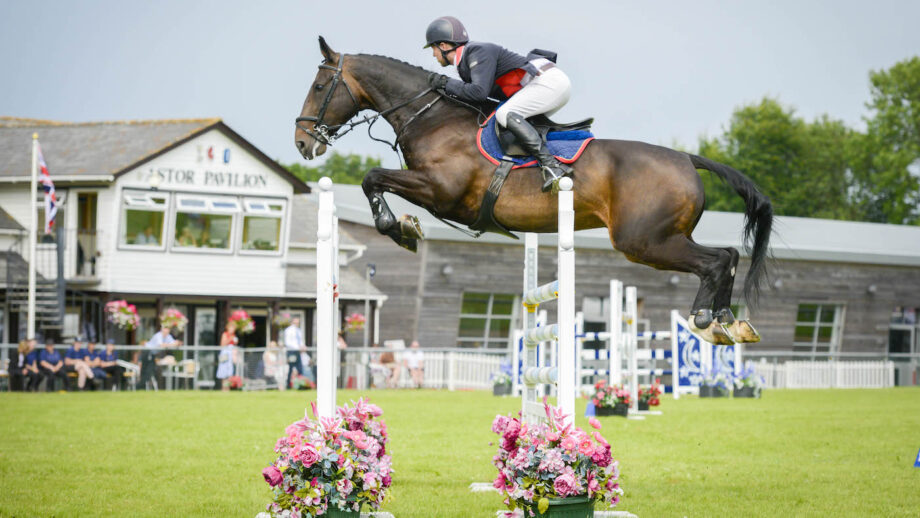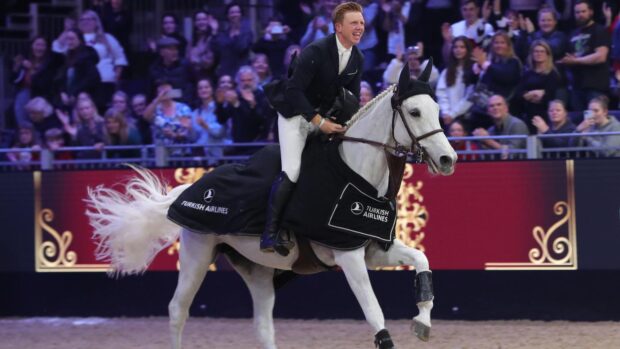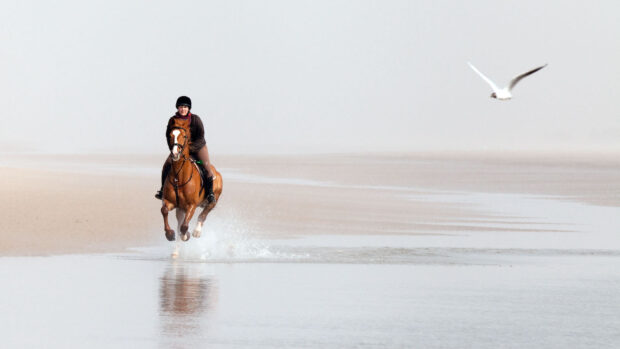Showjumper Mark Edwards is a regular sight in the top shows both home and abroad, but what is perhaps even more remarkable is the number of home-breds he rides. The breeding side of his business has been paying dividends in terms of horsepower. The likes of Mark’s national championship-winning ride Montreuxs Tale, Tinkers Tale and Flying Tinker II are all proof of this.

Montreuxs Tale, sired by the Edwards’ Tinkers Tale out of a Corleone mare. Credit: Grossick Racing Photography
“We’ve been very lucky with the horses we have bred over the years; breeding is a tremendous amount of luck,” says Mark, who works alongside his father Martyn. “You can have the best mare and best stallion in the world and for whatever reason, more often than not you don’t get the result you were hoping for. But when you get a good one there is nothing more rewarding and exciting.
“It’s not going to happen overnight; even if the first one is a good one, it’s still a 10-year project. The first thing is to get a nice foal, all correct and everything. And then you can start dreaming from there.”
Mark says Martyn started with two mares; one line has produced most of their superstars.
“The other line, they will be nice horses, but not quite up to the standard we hope for,” he says. “But if you get a good dam line, it’s a case of keeping on trying. The mare has to be naturally scopey with a good stride, as the quality of movement comes a lot from the mare, but you always try to improve what your dam’s got; if you want a bit more quality or scope, you look for that type of stallion. If you want a real careful one, you look for different again.
“It’s lots of trial and error as well. We’re looking for broodmares as that’s where our success has come from but it’s a job to find the right ones – I think the more success you have, the more critical you become.”
The early days for showjumper Mark Edwards’ home-breds
Mark says the Edwards are lucky to have the space to breed but they only have two each year, as “how would you get round them all otherwise?” He has a business to run, clients’ horses to ride, and only so many hours in the day.
Foals of the same sex in the same season “more or less stay together till they’re backed”; if they have one of each gender, they are separated at weaning and go into different herds with others of similar age.
“Then it’s quite nice watching them play,” he adds. “We generally back them in the winter of their three-year-old year, then ride them 10–12 times, until they’re cantering around both arenas nicely, then leave them for a year. We won’t decide what we’re going to do with them then, but we have a good idea whether they’re going to go down the showjumping route or we’ve got to find another job for them.”
The five-year-olds might go to a few shows, Mark adds, but are generally learning at home rather than in the ring, having “plenty of time to grow up”.
“They’re still growing, and we’re very much looking at the long term,” he says. “Rather than trying to produce a youngster to sell, we’re trying to produce them for ourselves, so it’s always with the end goal in mind.”
The Edwards’ ethos with young horses is to do the work at home, be patient, and produce them with the future in mind.
“At home we like to work the horses as much as we can around the farm,” he says. “Cantering around the fields, working in open spaces, helps not only with the physical side of things; fitness and muscle strength, but also the mental side of things, and not just for the horse. Exercising around the farm, time seems to go a lot quicker!”
Assessing young showjumpers’ potential
Showjumper Mark Edwards says he will have a good idea from a young age as to whether individual home-breds will be future stars – but warns against judging too early.
“You need to give them a chance to learn to take off and develop their natural jump,” he says. “But what we look for, they’ve got to want to jump a lot of clear rounds. Whatever height they do, they’ve got to be careful and looking to leave the fences up. Because if they keep the jumps up, there’s always a job for them.
“You can tell quite early if they’re real careful types – whether they have the scope, you never really know until you get there and try it. Then, obviously, the stronger they get, the more, the more jump they generally find.”
And physical talent alone is not always enough.
“The mind and heart is a big, big thing to it,” he says. “If they haven’t got the right mindset, or are perhaps a bit chicken-hearted, they’re not going to go and achieve what you want them to achieve. But there’s no secret recipe; they’ve got brains! And if you try something with one horse, it might not work with the next one. You have to do everything with an open mind.”
Whether it’s a home-bred or one coming in to be ridden, Mark is also looking for range of movement, without which life will be harder for the horse.
“But you never really know until you get on and ride them, because one horse might look completely different to how it feels,” he says.
Some of his horses’ talent is clear from the start though; Dillinger, who arrived for backing and never left, competed in the Foxhunter and grade C finals at Horse of the Year Show (HOYS) 2022, then won an international class there a year later. Royale Tale, who also arrived for backing, won the newcomers and grade C at HOYS 2022, and also an international class there in 2023.

Mark is hugely excited by the prospects of Dillinger NE, by Diarado, who is not home-bred but has been his yard since backing. Credit: Peter Nixon
“Dillinger just had it from the word go,” says Mark of the 10-year-old he has previously said may be the best horse he’s ever had. “From the moment he started, he was jumping the right way; he has really nice movement. You always have the question mark about their scope when they’re four or five because you don’t try them over big jumps at that age, but he’s progressed and he’s really turning out to into the horse we thought he was in the beginning.
“He and Royale Tale are coming through together; they’re the same age and they’ve both kept on improving. She’s a real fighter in the ring; she’s got that attitude of, ‘Let me do it and everyone else will follow’.

“She’s a fighter”: Royale Tale, by Montreuxs Tale, won at HOYS in 2022 and 2023 and has continued to progress up the levels. Credit: Peter Nixon
“It’s a long process, and you’re always questioning if you’re doing the right thing in a way. But when it all works out, and you start reaping your rewards for taking all the time and producing, it makes it all worthwhile.”
With Flying Tinker, on the other hand, the 15.3hh 2023 H&H showjumping horse of the year, it was not as clear.

A home-bred success story: the courageous Flying Tinker, whom the Edwards deemed too small as a youngster, but has proved a keeper. Credit: Andrew Parker/Grossick Photography
“We really nearly sold him as a six-year-old!” Mark says. “We had that question mark on how much scope he had, and because he was only little as well, we sort of questioned, did he really have enough stride to go on? But luckily, we stuck to it.
“He’s definitely one who jumps off his heart. Perhaps he’s not the scopiest horse in the world, but he hates touching a fence, and that gives him that extra bit of scope that not many have.
“It’s always nice to win, whatever horse you’re on, but to do it on one you’ve seen from the word go, just adds to the whole value of why we do it. It gives you that extra bit of buzz, and you can’t really describe it. It’s what we do it for.”
You may also like to read…

*Exclusive* Daily learning, diligence and why you need to jump on grass – inside the mindset of a top-flight showjumper

*Exclusive* ‘If I could build a horse, it would be him’: Yasmin Ingham on the ingredients of a perfect eventer

*Exclusive* Ahead of the curve: train your horse to be soft yet strong with Alex Bragg’s jumping exercise on a turn

*Exclusive* Improve your horse’s footwork while jumping and have fun with Gemma Stevens’ gridwork exercise

*Exclusive* Are horses any more traceable since the shocking ‘Horses – Making a Killing’ TV documentary… and what else needs to be done?

*Exclusive* Improve your horse’s rideability and straightness with Harry Meade’s three-fence jumping exercise




